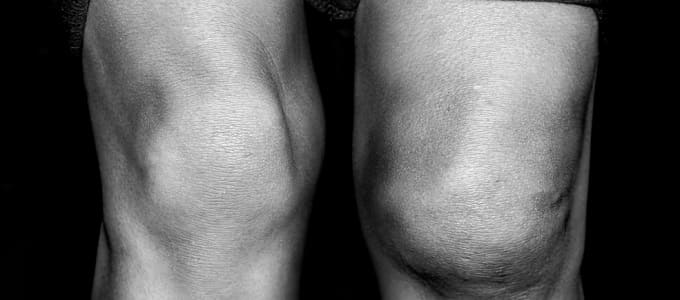
Pain in the kneecap is not only clearly focused, but the condition is also visually identifiable by the misplacement of the kneecap. Sometimes, however, pain in the kneecap radiates, making the pain more general.
Softening of Kneecap Cartilage
Problem
Chondromalacia is the softening of the cartilage, a condition occurring most frequently in the kneecap. The term comes from the Greek word malakta meaning "softness." Improper tracking of the kneecap through the femoral groove causes this softening, or degeneration, which is a form of arthritis. Reasons for this improper tracking include a "Q angle" of greater than 20 degrees, uneven strain on the kneecap, poor metabolism in the cartilage causing it to wear away prematurely, or femoral anteversion (a condition in which the knees seem to face each other because the entire leg is turned in at the hip).
The "Q angle" is the angle formed between two intersecting lines: an imaginary line extended from the hip joint, along the quadriceps, and through the knee joint (this is the angled line in the bottom of the capital Q) and a line drawn from the knee cap directly down to the tibial tubercle (the vertical axis). Ideally, the angle is 15 degrees, and any angle greater than 20 degrees indicates increased risk of improper tracking and therefore chondromalacia. Because girls′ hips widen as they grow older, their risk of chondromalacia increases as the Q angle widens.
Uneven weight training results in chondromalacia when muscles that have been worked unevenly put uneven strain on the kneecap. In some people, knee cartilage seems to wear out sooner than it does in others, and chondromalacia may be an indicator of this condition.
The Q-angle is ideally 15 degrees. An angle greater than 20 degrees indicates increased risk of improper tracking and perhaps chondromalacia. Because of wider hip bones, women are at greater risk, as are athletes who overdevelop quadriceps muscles and put uneven strain on the kneecap.
Symptoms
Initially, vague pain occurs when the kneecap moves outside the femoral groove. A grating or crunching accompanies knee bending. Pain increases with strain on the kneecap–squatting, lunging, or downhill walking. As the cartilage softens, swelling and tenderness spread from a focus on the kneecap in particular to the knee in general.
Solutions
With chondromalacia, pressing on the kneecap causes pain. Arthroscopy allows the physician to examine the back of the kneecap for definite indications of weakening. Because the causes of chondromalacia are mechanical and usually based on body structure, no surgical intervention or miracle medicine can cure the condition; however, a balanced exercise program including quadriceps exercises to help reduce strain on the kneecap will help. Bicycling with the seat high and the gears low provides good exercise. Anti-inflammatory drugs may help relieve some inflammation caused by the misalignment.
This is a section from Dr. Jack E, Jensen′s book The One Stop Knee Shop. Read the next section Kneecap Dislocation.


